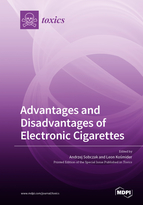Advantages and Disadvantages of Electronic Cigarettes
A special issue of Toxics (ISSN 2305-6304). This special issue belongs to the section "Novel Methods in Toxicology Research".
Deadline for manuscript submissions: closed (31 August 2022) | Viewed by 59033
Special Issue Editors
Interests: tobacco harm reduction; global health; e-cigarettes; nicotine; toxicology of tobacco smoke; vaping; biomarkers
Interests: e-cigarettes; nicotine; toxicants; smoking cessation; analytical chemistry of biomarkers
Special Issues, Collections and Topics in MDPI journals
Special Issue Information
Dear colleagues,
Electronic cigarettes (ECs) have been present on the consumer market for over a decade, and the number of scientific publications in the PubMed database has now exceeded seven thousand. Despite the number of publications, there is still no consensus in the scientific community about their safety. However, it should be emphasized that a comparison of the equivalent quantities of tobacco smoke and the aerosol produced from e-cigarettes shows a significantly lower quantity of toxic compounds in the aerosol compared with tobacco smoke. This can be seen as a way of reducing the health damage to cigarette smokers who cannot or are unwilling to quit using conventional methods. In addition, randomized studies are emerging suggesting that ECs could be useful in smoking cessation. On the other hand, ECs are now widely used among adolescents, and may pose a serious risk of future nicotine dependence and health problems in this population, as they counteract the population’s gains from smokers who quit using them. Therefore, as most authors stress, further research is needed that will convincingly resolve the current controversies. Clinicians urgently need evidence-based knowledge to better inform their patients about the use of these emerging tobacco products as a harm-reduction strategy, and regulators to regulate these products in ways that best serve public health, especially taking the youth population into account.
For this Special Issue, we welcome a broad range of studies examining the health effects of ECs. In particular, we welcome original research articles or systematic reviews that focus on the following:
(1) Chemical composition of refill solutions and ECs’ aerosol.
(2) Studies on new tobacco/nicotine products, such as e-cigarettes, snus, and heat but not burn tobacco products in relation to the health impact of these products.
(3) Observational population studies on EC use.
(4) Intervention studies designed to prevent youths from starting to use smoked or smokeless tobacco, as well as studies designed to prevent nicotine addiction that may result from novel nicotine-containing products.
(5) Smoking cessation studies among adult smokers, including studies of novel approaches to smoking cessation. Of special interest are studies that demonstrate the potential efficacy of using vaporized nicotine products, including e-cigarettes, as a type of nicotine replacement for addicted smokers who want to quit.
Prof. Dr. Andrzej Sobczak
Dr. Leon Kośmider
Guest Editors
Manuscript Submission Information
Manuscripts should be submitted online at www.mdpi.com by registering and logging in to this website. Once you are registered, click here to go to the submission form. Manuscripts can be submitted until the deadline. All submissions that pass pre-check are peer-reviewed. Accepted papers will be published continuously in the journal (as soon as accepted) and will be listed together on the special issue website. Research articles, review articles as well as short communications are invited. For planned papers, a title and short abstract (about 100 words) can be sent to the Editorial Office for announcement on this website.
Submitted manuscripts should not have been published previously, nor be under consideration for publication elsewhere (except conference proceedings papers). All manuscripts are thoroughly refereed through a single-blind peer-review process. A guide for authors and other relevant information for submission of manuscripts is available on the Instructions for Authors page. Toxics is an international peer-reviewed open access monthly journal published by MDPI.
Please visit the Instructions for Authors page before submitting a manuscript. The Article Processing Charge (APC) for publication in this open access journal is 2600 CHF (Swiss Francs). Submitted papers should be well formatted and use good English. Authors may use MDPI's English editing service prior to publication or during author revisions.
Keywords
- e-cigarettes
- global health
- vaping
- tobacco smoke
- toxicants
- cessation








